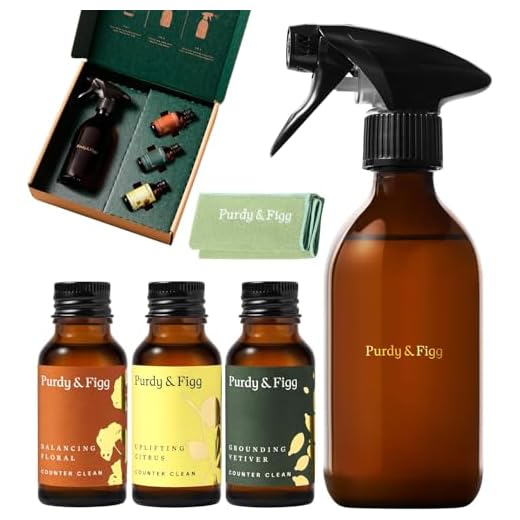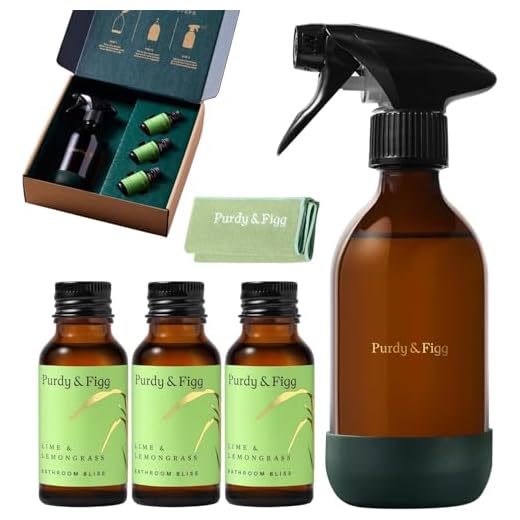




Opt for solutions like vinegar and baking soda. These natural ingredients not only disinfect but are also non-toxic for your furry companion. A simple mixture of equal parts white vinegar and water can effectively clean surfaces without posing any harm to pets.
Another great choice is hydrogen peroxide at a 3% concentration. It offers antibacterial properties while being less hazardous compared to commercial products. Just ensure that any residue is thoroughly wiped away after cleaning, keeping your pet safe from any lingering substances.
Avoid using bleach or ammonia-based products, as they can be harmful if ingested or inhaled. Always check labels for pet safety warnings before using any cleaner. It’s wise to let surfaces dry completely before allowing your four-legged friend back into the area.
When it comes to maintaining a clean environment for your pet, opting for safer alternatives not only protects their health but also contributes to a happier home. My dog, Charlie, thrives in a clean space, and I feel good knowing I’m using products that won’t harm him.
Safe Cleaning Options for Your Canine Companion
Hydrogen peroxide is a solid choice for sanitising surfaces where your furry friend roams. A 3% solution can effectively eliminate most bacteria and viruses without leaving harmful residues. Make sure to rinse the area with water after application to avoid any irritation.
Vinegar’s Versatility
White vinegar serves as a natural alternative, boasting antimicrobial properties. Mix equal parts vinegar and water to create a cleaning solution. This blend is excellent for wiping down floors and furniture, providing a fresh scent while keeping your space safe for your pet.
Coconut Oil Benefits
Coconut oil isn’t just a treat for dogs; it can also act as a gentle disinfectant. Applying it to non-porous surfaces not only cleans but also leaves a protective layer. It’s particularly useful for keeping your pet’s toys and bowls germ-free.
Understanding Dog-Friendly Ingredients in Disinfectants
Look for products containing natural components like vinegar, baking soda, or hydrogen peroxide. These substances are less likely to cause harm to your furry friend while still offering a decent cleaning effect. Vinegar, for example, not only disinfects but also neutralises odours, making it a favourite in many homes with pets.
Avoid anything with phenols, quaternary ammonium compounds, or strong alcohols. These can irritate your dog’s skin and respiratory system. Instead, opt for items that list plant-based ingredients or are specifically labelled as pet-friendly.
It’s also beneficial to check for eco-certifications. Brands that adhere to environmental standards often use safer formulations. This can give you peace of mind when cleaning spaces your pet frequents.
Be cautious with essential oils; while some can be beneficial, others like tea tree or citrus oils can be toxic. Always research or consult your vet before using products containing these oils around your pet.
After cleaning, ensure the area is well-ventilated and dry before allowing your dog back in. This helps minimise any potential exposure to residues. For older pets who may have specific dietary issues, check out this best food for old dogs that wont eat for additional support.
By choosing the right ingredients, you can maintain a clean home without compromising your dog’s health. Always prioritise safety when selecting cleaning agents, and you’ll create a harmonious living space for both you and your canine companion.
Top Commercial Cleaners Approved for Pet Use
Here are some excellent options that I trust for keeping my space clean without worrying about my furry friend. One of my favourites is the Eco-88 Cleaner. It’s derived from natural ingredients and effectively tackles stains and odours while being gentle on the environment. I’ve used it after my pup had a little accident, and it works wonders without leaving harmful residues.
Simple Green Bio Dog
Another solid choice is Simple Green Bio Dog. This product is specifically designed with pets in mind, ensuring that while it cleans, it doesn’t compromise the safety of your canine companion. It’s biodegradable and free from harsh chemicals. I’ve found it particularly useful for wiping down surfaces that my dog frequently interacts with. It’s reassuring knowing I’m not exposing him to anything harmful.
Puracy Multi-Surface Cleaner
Puracy Multi-Surface Cleaner is another reliable option. This cleaner is formulated with plant-based ingredients, making it safe for pets. I love using it for various surfaces around my home, from counters to floors. The fresh scent it leaves behind is a bonus, and my dog hasn’t shown any adverse reactions after I use it. It’s a great way to maintain cleanliness while prioritising his health.
Homemade Solutions That Are Pet-Friendly
Vinegar and water is a fantastic mix for cleaning surfaces. Combine equal parts of white vinegar and water in a spray bottle. This concoction effectively eliminates bacteria without posing a threat to furry companions. Just be careful with the scent; some pets might find it strong.
Simple Ingredients for a Safe Clean
- Baking Soda: Sprinkle on carpets or upholstery, leave for a while, then vacuum it up. It neutralises odours and is completely harmless to pets.
- Castile Soap: Mix a tablespoon with water for a gentle cleaner. It’s biodegradable and non-toxic, making it perfect for homes with animals.
- Essential Oils: Use with caution. Only select oils like lavender or chamomile, and always dilute them. Some oils can be toxic; make sure to research before use.
Crafting Your Own Cleanser
For a more robust solution, create a citrus cleaner. Combine the peels of lemons or oranges with vinegar in a jar. Let it sit for a week, then strain the liquid. This natural alternative not only disinfects but also leaves a fresh scent.
Always test any new mixture on a small area first. Monitor your pet’s behaviour after cleaning. If you notice any unusual reactions, discontinue use immediately.
How to Properly Use Disinfectants Around Dogs
Always ventilate the area before applying any cleaning products. Open windows and doors to ensure fresh air circulation, which helps minimise harmful fumes that could affect your furry friend. I learned this the hard way when I noticed my dog sneezing after I cleaned the floor without proper ventilation.
Application Tips
Use a spray bottle for precise application. This approach reduces the amount of product that settles on surfaces and allows for better control. I remember using a mop with a cleaner that wasn’t pet-friendly and regretting it for days. Instead, I now spray surfaces lightly and wipe them down thoroughly with a cloth.
Ensure surfaces are completely dry before allowing your pet back into the area. Some ingredients can linger even after a surface appears dry, posing a risk to your canine companion. I always wait at least an hour after cleaning before letting my dog roam around again.
Storage and Disposal
Store all cleaning agents securely out of your pet’s reach. I once had a scare when my curious pup knocked over a bottle I thought was safely tucked away. It’s best to keep products in high cabinets or locked shelves to prevent accidental ingestion.
Dispose of any unused or expired products properly. Follow local guidelines for hazardous waste to ensure safety for all household members. This practice not only protects your dog but also contributes to a healthier environment.
Signs of Disinfectant Toxicity in Dogs
Watch for excessive drooling or unusual behaviours. If your furry friend starts to exhibit signs like these, it could indicate a reaction to harmful chemicals. Symptoms may include vomiting, lethargy, or difficulty breathing. Pay special attention to any sudden changes in appetite or energy levels, as these can also signal trouble.
Physical Reactions
Skin irritation is another clear indicator. Look for redness, swelling, or persistent scratching. If your canine companion develops these symptoms after exposure to cleaning products, it’s best to consult a vet immediately. Ingesting any toxic substances might lead to more serious complications. Signs of oral irritation include pawing at the mouth or refusing food.
Behavioural Changes
Anxiety or restlessness could also be a response to chemicals nearby. If your pup seems more anxious than usual or hides away, take note of the environment. Ensure that fresh air circulates, and your pet has a safe space away from any potential irritants. If these signs persist, a visit to the vet can help rule out any serious issues and provide peace of mind.
FAQ:
What types of disinfectants are safe to use around dogs?
When choosing disinfectants safe for dogs, it’s best to opt for products that are labelled as pet-friendly or non-toxic. Common examples include vinegar, baking soda, hydrogen peroxide (in diluted form), and products specifically designed for pet owners that contain natural ingredients. Always ensure to follow the manufacturer’s instructions and allow surfaces to dry completely before letting your dog back into the area.
Are there any disinfectants I should avoid using if I have a dog?
Many common household disinfectants can be harmful to dogs. Products containing bleach, ammonia, or strong essential oils can be toxic if ingested or if a dog comes into contact with them. It’s advisable to avoid any disinfectants that do not clearly state they are safe for pets, and always store cleaning products out of reach of animals.
How can I safely disinfect my home without harming my dog?
To disinfect your home safely, consider using a mixture of vinegar and water or a baking soda paste for cleaning surfaces. If you choose to use commercial cleaning products, look for those labelled as non-toxic or pet-safe. Always ventilate the area while cleaning, and ensure that your dog is kept away from treated surfaces until they are completely dry. Regular cleaning can help maintain a hygienic environment without heavy reliance on harsh chemicals.
Is it safe to use essential oils as disinfectants around dogs?
While some essential oils can have disinfectant properties, many are not safe for dogs. Oils like tea tree, pine, and citrus can be toxic to pets. If you wish to use essential oils, consult with a veterinarian about which ones are safe to use around your dog. It’s also important to ensure that any oils are properly diluted and not directly applied to your dog’s skin or fur.
What should I do if my dog gets into a cleaning product?
If your dog accidentally ingests or comes into contact with a cleaning product, it’s important to act quickly. First, check the product label for any emergency instructions. If the product is toxic, contact your veterinarian or an emergency animal poison control hotline immediately. Provide them with details about the cleaning product and your dog’s symptoms. Prompt action can be crucial in ensuring your dog’s safety.
What are some disinfectants that are safe to use around dogs?
When looking for disinfectants safe for dogs, consider using those made with natural ingredients. Products containing vinegar, baking soda, or hydrogen peroxide in low concentrations can be effective. These options are less likely to cause harm to your pet compared to harsher chemicals. Always ensure that the area is well-ventilated and allow surfaces to dry completely before letting your dog back into the area.
How can I ensure that a disinfectant is safe for my dog?
To ensure a disinfectant is safe for your dog, read the label carefully. Look for products specifically marked as pet-safe or non-toxic. Avoid those with strong fragrances, bleach, or ammonium compounds, as these can be harmful. It’s also wise to consult your veterinarian before using a new product, especially if your dog has pre-existing health conditions. If you choose to use a disinfectant, consider testing it in a small area first and observe your dog’s reaction to it.








